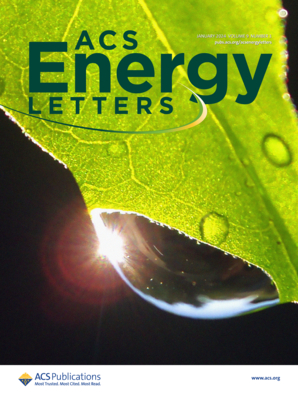设计用于硅阳极的稳定中空颗粒
IF 18.2
1区 材料科学
Q1 CHEMISTRY, PHYSICAL
引用次数: 0
摘要
硅电极有望将锂离子电池的容量提高十倍。然而,硅颗粒在插入和提取锂时产生的巨大体积变化阻碍了它们的商业应用。多孔硅结构的优化设计旨在改善这一缺点,需要在硅负极颗粒及其团聚的化学机械行为数学模型的指导下进行实验。我们提出了这样一个模型,该模型描述了空心或实心颗粒的体积和伴随应力在电位静态和电位静态工作条件下的时间演变。该模型可用于优化设计参数--粒子尺寸、粒子厚度和充电曲线--以提高能量密度,同时保持稳定的弹性运行。它准确地预测了实验观察到的硅中锂的部分摩尔体积值。我们的模型还为多粒子电极系统中的化学机械相互作用提供了基本见解,这对硅电极技术的发展至关重要。本文章由计算机程序翻译,如有差异,请以英文原文为准。

Design of Stable Hollow Particles for Silicon Anodes
Silicon electrodes hold a promise of increasing the capacity of lithium-ion batteries ten-fold. Yet, their commercial deployment is hampered by large volume changes of silicon particles in response to lithium insertion and extraction. Optimal design of porous silicon structures, aimed at ameliorating this drawback, requires experimentation guided by mathematical models of the chemomechanical behavior of silicon-anode particles and their agglomerations. We present such a model that describes the temporal evolution of a hollow or solid particle’s volume and concomitant stresses, for both galvanostatic and potentiostatic operating conditions. This model is used to optimize design parameters─particle size, particle thickness, and charging profiles─for energy density, while maintaining stable elastic operation. It accurately predicts the experimentally observed value of the partial molar volume of lithium in silicon. Our model also furnishes fundamental insights into chemomechanical interactions in multiparticle electrode systems, which are crucial for advancement of the silicon-electrode technology.
求助全文
通过发布文献求助,成功后即可免费获取论文全文。
去求助
来源期刊

ACS Energy Letters
Energy-Renewable Energy, Sustainability and the Environment
CiteScore
31.20
自引率
5.00%
发文量
469
审稿时长
1 months
期刊介绍:
ACS Energy Letters is a monthly journal that publishes papers reporting new scientific advances in energy research. The journal focuses on topics that are of interest to scientists working in the fundamental and applied sciences. Rapid publication is a central criterion for acceptance, and the journal is known for its quick publication times, with an average of 4-6 weeks from submission to web publication in As Soon As Publishable format.
ACS Energy Letters is ranked as the number one journal in the Web of Science Electrochemistry category. It also ranks within the top 10 journals for Physical Chemistry, Energy & Fuels, and Nanoscience & Nanotechnology.
The journal offers several types of articles, including Letters, Energy Express, Perspectives, Reviews, Editorials, Viewpoints and Energy Focus. Additionally, authors have the option to submit videos that summarize or support the information presented in a Perspective or Review article, which can be highlighted on the journal's website. ACS Energy Letters is abstracted and indexed in Chemical Abstracts Service/SciFinder, EBSCO-summon, PubMed, Web of Science, Scopus and Portico.
 求助内容:
求助内容: 应助结果提醒方式:
应助结果提醒方式:


